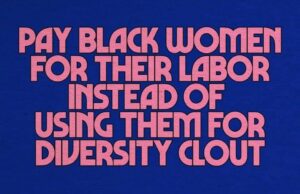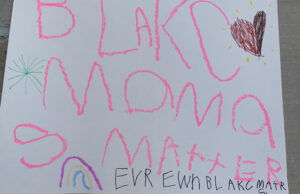#BlackSkinWhiteSin: The Black Church, Black Women and Sexual Discourses of Resistance [Revised]
 On Monday January 30th, as America spiraled out into unparalleled capitalist, sexist, hetero-patriarchal, homophobic, ableist, white nationalist, Islamophobic, devilish entropy, discombobulation and corruption, Dr. Juanita Bynum, a black American Pentecostal preacher, televangelist, gospel singer, author and entrepreneur, most widely known for her sermon “No More Sheets,” released a videogram for “No More Sheets, Part 2.” The video, with its conspicuous placement of all caps and 27 exclamation points, vociferated the following:
On Monday January 30th, as America spiraled out into unparalleled capitalist, sexist, hetero-patriarchal, homophobic, ableist, white nationalist, Islamophobic, devilish entropy, discombobulation and corruption, Dr. Juanita Bynum, a black American Pentecostal preacher, televangelist, gospel singer, author and entrepreneur, most widely known for her sermon “No More Sheets,” released a videogram for “No More Sheets, Part 2.” The video, with its conspicuous placement of all caps and 27 exclamation points, vociferated the following:
I….AM….. GOING…. TO…. SIT…. THIS….ONE……RIGHT….HERE!!!!!!!!! IT SHALL NOT BE MOVED!!!!!
NO MORE SHEETS PART 2!!!!!
WHAT IN THE WORLD????!!
EVERY WOMAN NEED [sic] TO WATCH THIS VIDEO!!!!!!
That is, as human rights protests erupted all over North American soil, as refugees and immigrants – green card holders and people with valid visas alike – from Iran, Iraq, Syria, Sudan, Libya, Yemen and Somalia were banned from entering America, as worshippers at a mosque in Quebec City were murdered, as white supremacist, Steve Bannon, debuted on the National Security Council, as Chief Petty Officer, William “Ryan” Owens, a U.S. Navy Seal, became the first American to die in combat under Donald Trump in a raid against al Qaeda in Yemen, and as the black diaspora in America hollered and threw up their hands, not in shock or amazement but rather deep vexation at the current state of affairs, Bynum, President of Juanita Bynum Ministries and CEO of Juanita Bynum Enterprises, thought it not robbery to invite the viewing audience into a mass mediated perfervid discourse on hoing (as in whoredom) and holiness.
To be sure, if anyone is skilled at holding multiple phenomena together at once, that is, walking and chewing gum with both vehemence and zeal, it is the black preacher. Yet the fervor with which Bynum fixated on and delineated between hoing and holiness – in which the former is so clearly racialized, classed and gendered, and the latter, a reminder of why William James’ idea of ‘immediate luminousness’ may be useful but simultaneously defective – should give us pause. In his seminal text, Varieties of Religious Experience (1902), James posits that religious experience, if true, should be corroborated and thus verified by the fulfillment of corresponding behaviors and habits, for example, outward forms of piety. Ultimately, religious experience, performance, participation, and ritual, such as attending service, prayer, fasting, reading, and purging, should result in a transformative experience that leads to a verifiable ethics of renewed conduct.
Similarly, within the Black Church, and more specifically the black holiness tradition from which Bynum emerges, it is believed that religious experience and/or conversion should lead one to exhibit what I’d like to refer to as holy conduct, a way of life that problematizes and outwardly rejects “worldly” pursuits such as lust – of the flesh, eyes, sin, life, etc. The appropriate response to such worldliness is not only repentance but willful domination of the flesh, puritanical coercion and consent, if you will. Two things that should not be missed in this equation: One, how discourses on holiness and religious piety, achieved statuses based on a set of cultural directives, often coil out and into coinciding expositions on purity, virtue, and respectability. And two, how domination of the flesh (puritanical constraints), for women and girls in particular, gets authenticated by mythical ideologies of purity.
While one can write a dissertation on the nuancing between these terms, my interest here is in the harmful overlapping and layering of religio-cultural interpretation for women and girls. Purity – the absence of [sexual and/or worldly] contamination – serves as proof of principled and moral high ground, of holy living and thus of virtuous abstaining. However, as culturally inscribed notions of femininity, distinguishable by history, origins, race, class, sex and sexuality go, purity is a myth largely unavailable to black women and girls. The cultural interpretation of the corporeality where colonization, race, class and gender intersect assumes a state of perpetual pollution, or, as Frantz Fanon articulated in Black Skin, White Masks (1967), a state akin to a “chemical solution…fixed by a dye.” With this in mind, puritanical domination of the flesh for black women and girls becomes both a communal and circular project in which virtue, as it allows black women and girls to make themselves over in ways purity myths simply can’t, stands in as proxy.
Bynum is certainly not the first to note hoing and holiness as natural opposites. Religious discourses on holiness, piety, purity and virtue have long trafficked in oppositional gendered narratives on hyper-sexuality. A close reading of the “virtuous woman” in Proverbs 31: 10-31 provides a clue for such diametrical pairing. According to Proverbs 31, virtue is found in not only domesticity and hard work but also wifedom and motherhood, both of which provide access to ideals of true womanhood. And pivotal to being a “true” woman for black women and girls historically denied womanhood as a category of social location and identity and interpreted as quintessentially different due to white racist philosophical and scientific claims of physiognomical, physiological and temperamental difference (Sharpley-Whiting, 1999) at least since the Middle Ages, is virtuous/holy drag – the perfecting of the cloak of virtue, which reimagines access to *divine purity and is substantiated through behavior and dress.
In Sexuality and the Black Church: A Womanist Perspective (1999), Kelly Brown Douglas notes that the conditions of slavery forced African women to bare their bodies and breed multiple children, making bondwomen’s reproductive abilities, licentiousness and immorality seem inseparable. With the institutionalization of nakedness distinguishing between white and black *women, dress came to signify free status, labor (or lack thereof), morality and socio-economic class. Covering, then, came to denote humanity, piety and virtue. Hence, for Bynum, virtuous/holy drag is noted in the length and looseness of clothing, the covering of the flesh, and particularly, the nipples, buttocks and breast cleavage (side and front). Tight clothing, visible flesh, dimpled buttocks, the absence of nipple covers, and “thongy stringy shoes…[while having] your legs all greased up…during praise and worship” are commensurate with a having a “ho spirit.” She exclaims, “I’M NEVER GOING TO BUY NAKED AND HO!”
Bynum declares, “When you are aroused by faith you refuse to become the next ho on the street!” Here, “ho on the street” stands in opposition to the lady, woman or wife “in the house,” whether a personal or institutional dwelling. But the diametric between public and private has roots in discourses equating women and the public sphere (streets) with prostitution and women and the private sphere with domesticity, virtue and respectability. Thus, virtuous/holy drag for black women and girls enables not only the appearance of modesty and respectability, but racial uplift through the demarcation between black publics and privates, the latter of which has been historically erratic at best. More, an undergirding ideology of virtue, respectability and racial uplift is sexual shame – the impetus behind the dichotomous ho’s and ladies, the latter of which is imagined to eventually become housewives (“can’t turn a ho into a housewife”). Both of which, ladyhood and housewifery, are meant to quell concupiscence. And both of which should exude virtuous/holy drag, not a “ho spirit” through dress and praxis.
Like those before her, Bynum calls on us to appropriate the master’s discourse – in the name of Jesus. She marks her viewers with sexual deviance and otherness and admonishes them to give up hoing and let their ‘lee’ find their ‘ho’ so that they can be “HO-LY” and rebukes those who have chosen “freakiness” over being “free” by tempting other women’s husbands through vanity and failing to dress the part of one who has been transformed through religious experience. Yet, what does it mean that Bynum, like so many others before her, swathes black women and girls in what Fanon refers to as “crushing objecthood”? Are the projections, “dirty nigger!” or “look, a negro!,” he writes about much different from Bynum’s précis on hoing and having a “ho spirit”? Do both not draw upon racist and sexist epistemes of modernity, which mean to seal black flesh into simultaneous non-being and hyper-being?
Do they not both note the transnational political project of making black diasporic folk over – “imagining them as objects…renaming, dismembering, restoring and weaving them out into another self – from without” (Jezebel Unhinged: Loosing the Black Female Body in Black Religion and Black Popular Culture, forthcoming)? Both projections imagine black flesh as synonymous with dirtiness, moral contamination and sin. Both employ adjectives to modify the noun. Both construct narratives of difference. Both highlight the grotesque fascination, fear, fantasy and desire “to produce and sustain the illusion of…absolute truth, thereby effecting mastery of otherness” T. Denean Sharpley-Whiting writes about in Black Venus: Sexualized Savages, Primal Fears, and Primitive Narratives in French (1999). And both sublimate white obsessions with and violent sins against black skin with supposed black pathological difference.
This messy interweaving elicits a collective response. What follows is a forum that hopes to turn the presiding meta-discourse on black women and girls’ bodies and sex lives in the Black Church and beyond right side up. It means to construct what Douglas refers to as a “sexual discourse of resistance,” however, revised. Douglas posits that white racism and white patriarchy combined created a white culture that advances a politics of racial, cultural and sexual difference, where whiteness offers the standard while attempting to deteriorate black humanity. A sexual discourse of resistance works to restructure white normative gazing, which attaches evil and wantonness to black bodies and purity and goodness to white bodies. However, a sexual discourse of resistance revised notes the concomitant structuring of black sexual pathology in structural racism, state sanctioned violence, patriarchy, and both white (including white identifying) and black normative gazing and mass mediating. It notes sexual shame and secrecy as non-negotiable points of ceaseless refusal, wherever they exist, including churches, communities, collectives and academic discourse. It interprets black flesh as born holy and black sexual discourse as complex, winding, contradictory, and sometimes downright ugly. And, as Joan Morgan asserts in her essay, “Why We Get Off: Moving Towards a Black Feminist Politics of Pleasure,” it understands “a healthy erotic as a fundamental right.”
That is, this forum invites writers to lay the groundwork for critiquing historical racist and sexist meta-narratives projected onto black women and girls’ flesh while taking to task black appropriation of such narratives, including black self-determination and self-designation. Meaning, it is one thing for Bynum to theologize black women’s sex and bodies as the preeminent site of unholiness and sexual perversion, it is another for over 80,000 commenters to overwhelmingly respond affirmatively. Additionally, we call on readers to refuse narratives that reduce black women’s sexual politics to suffering and survival and instead to explore what Morgan notes as the “the complex, messy, sticky, and even joyous negotiations of agency and desire that are irrevocably twinned with our pain.” Particularly, how might we more effectively engage black women who love God and sex – especially those beyond the boundaries of heterosexual marriage? And what of those who deploy “ho discourse” (Jezebel Unhinged: Loosing the Black Female Body in Black Religion and Black Popular Culture, forthcoming) as a framework of self-articulation and autonomous sexual decision-making?
A black sexual discourse revised is disinterested in neat binaries that contradict our intricate lives. With that said, as Morgan encourages us in When Chickenheads Come Home to Roost: A Hip-Hop Feminist Breaks It Down (2000), this forum intends to “fuck with the grays.” However, in no way does this forum mean to cover all bases. That is impossible, especially in this space and time. What it hopes to do is shift the discourse – in black churches, black communal and cultural spaces, black interiorities, and black academic religious and theological discourse. It aspires to play in what Morgan notes as “pleasure politics” while refusing narratives like: black women and girls aren’t born into this world already sacred, black women’s sexual decision-making and experience are synonymous with sexual deviance, sex is contrary to holiness, black women and girls are defined by their dress and/or sex lives, or, barring whatever happens when one is aroused by Jesus (Bynum), black women, and especially those affiliated with black churches, are “allergic to pleasure.”
Contrary to what Bynum, T.D. Jakes, Tyler Perry, Steve Harvey and whomever else may think, black women are fully capable of determining what is “proper,” good, useful and life-giving for themselves based upon the code of ethics they choose to live by. We don’t need another pornotropic video, conference, sermon, workbook, film, inspirational book or stage-play deploying hoing, promiscuity, or being fast as a normative framework for reinterpreting black women and girls’ bodies and sexual lives as always already immoral. What we need is less black folk playing in white supremacist capitalist patriarchal imaginings. We need our folk to commit to challenging, on personal, interpersonal and collective levels, the ways in which racial and gendered stereotyping was historically and is contemporarily complicit in state violence against black people. We need honest talk around race, gender, religion, sex, autonomy, consent, violence, pleasure, responsibility and accountability.
And more, we need new language and categories of analyses, for not only hoing but also holiness. Hoing, as a socially constructed pejorative projection, means to problematize, limit, regulate and reconfigure black women’s sexual agency as inherently threatening and corrupt. Reimagining black women and girls’ bodies as already sacred and sexual agency as both a virtue and fundamental right, rather than illicit, just might open up conversation for thinking about pleasure and desire as not only legitimate voicings of those made in God’s own image, but utterances also significant to the Divine. As my friend and colleague, Keri Day recently noted, if holiness is “based on our re-imaging of our God concepts…I want to suggest that folks ideas and imaginings about God open up or delimit what holiness can be as people pursue wholeness and right ways of relating to one’s neighbor. Because if holiness is about being as God is, we have a lot of interpretive work to do in relation to our ideas about God.”
Amen and Ashe.
 Tamura Lomax is an educator, writer and believer in social justice. She received her Ph.D. from Vanderbilt University in Religion where she specialized in Black Religion and Black Diaspora Studies. In 2014 she published Womanist and Black Feminist Responses to Tyler Perry’s Cultural Productions (Palgrave Macmillan), a co-authored edited volume with Rhon S. Manigault-Bryant and Carol B. Duncan, and is presently finishing up her first single authored monograph, Jezebel Unhinged: Loosing the Black Female Body in Black Religion and Black Popular Culture (Duke University Press). She is co-founder, along with Hortense Spillers, of The Feminist Wire.
Tamura Lomax is an educator, writer and believer in social justice. She received her Ph.D. from Vanderbilt University in Religion where she specialized in Black Religion and Black Diaspora Studies. In 2014 she published Womanist and Black Feminist Responses to Tyler Perry’s Cultural Productions (Palgrave Macmillan), a co-authored edited volume with Rhon S. Manigault-Bryant and Carol B. Duncan, and is presently finishing up her first single authored monograph, Jezebel Unhinged: Loosing the Black Female Body in Black Religion and Black Popular Culture (Duke University Press). She is co-founder, along with Hortense Spillers, of The Feminist Wire.




Pingback: #BlackSkinWhiteSin: From Pernicious Editing to Audacious Rescripting (Benediction) - The Feminist Wire